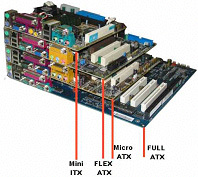Compact All-Rounders: VIA's Eden Mini ITX Format Boards
Form Factors For The Desktop: From ATX To ITX
We should be clear about one thing: the ATX standard is too big. Although pizza-box-sized motherboards for professional and home use are unlikely to disappear altogether, it is interesting to note that more than half of all PCs sold today are based on MicroATX format boards. The main factor that is driving this development is an upward pressure on costs, which inevitably leads to a reduction in the size and weight of complete systems. You can simply get more mini towers than full towers in a twenty-foot container.
This diagram, which we found on the VIA website, clearly shows the size differences.
The Flex ATX standard holds out the prospect of systems that are even smaller than the Mini ATX. However, it is the Mini ITX standard as proposed and championed by VIA that promises to deliver the solution for the really small PC of tomorrow.
| Header Cell - Column 0 | ATX | Micro ATX | Flex ATX | Mini ITX |
|---|---|---|---|---|
| Width x depth, max. | 305 x 244 mm | 244 x 244 mm | 229 x 191 mm | 170 x 170 mm |
| Size relative to ATX | 100% | 80% | 59% | 39% |
The Usual Problems: Too Hot, Too Loud, Too Inconvenient
Anyone who has assembled a computer system knows how frustrating it can be. You spend ages fitting a cable neatly inside the case only to discover that the plug won't fit. Then, you suddenly realize that you have made a mistake and have to backtrack by taking all your carefully assembled components out.
And even when everything is wired up, plugged in, slotted in and screwed down, you still can't take your eye off the ball. You have to make sure that the interior of your case is relatively tidy in order to ensure adequate ventilation - de rigueur for powerful computers running hot processors. Then, to combat the heat generated inside the case, we are obliged to install numerous fans (power supply, case, graphics card, CPU), which create a considerable racket that is surely not good for the nerves.
In order to put an end to this situation, we feel that two things are urgently required. Firstly, we must banish cable spaghetti forever by embracing the widespread adoption of Serial ATA (for CD/DVD drives too) and dispensing with the floppy disk drive. Then, we must find ways of cooling the system components, especially the CPU, without creating excessive noise. It is clear that generously dimensioned fans have to be employed, because small fans have to run at higher speeds, generating comparatively more motor whine and wind noise.
Get Tom's Hardware's best news and in-depth reviews, straight to your inbox.
Current page: Form Factors For The Desktop: From ATX To ITX
Prev Page Size Matters: Mini ITX Boards Tested Next Page VIA Processor On Board
Patrick Schmid was the editor-in-chief for Tom's Hardware from 2005 to 2006. He wrote numerous articles on a wide range of hardware topics, including storage, CPUs, and system builds.
